
Closeburn is a village and civil parish in Dumfries and Galloway, Scotland. The village is on the A76 road 2+1⁄2 miles (4 km) south of Thornhill. In the 2001 census, Closeburn had a population of 1,119. Closeburn is recorded as Killosbern in 1185. The first element of the name is Gaelic cill 'cell or church'. The second element is a saint's name, but none has definitely been identified.
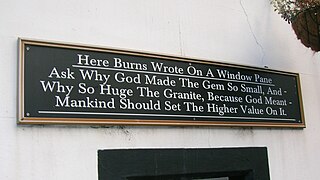
Robert Burns came to know James Cunninghamme, Earl of Glencairn in Edinburgh in 1786 through a 'Letter of Introduction' provided by Dalrymple of Orangefield who was married to Lady Glencairn's sister. The Earl received the poet warmly in his house and introduced him to his friends. One of several gifts from the earl to the poet was a diamond point pen, stylus, or cutter which he used to write upon many windowpanes and glasses, scribing verse, his signature, epigrams, or other writings for posterity. Many of these diamond-point engravings survive, some however are contentious as regards either their authenticity, meaning, or both.

Brownhill Inn, now just called Brownhill, was an inn approximately 1 mile (1.6 km) mile south of Closeburn, on the A76, which itself is about 2 miles (3.2 km) south of Thornhill, in Dumfries and Galloway, Scotland. Built in approximately 1790, this old coaching inn has undergone extensive changes, and the south side of the original property appears little changed whilst part of the inn has been demolished. The inns facilities used to include the once-extensive 12 stall livery stables on the west side of the road, but these have been sold and converted to farm buildings after the inn closed. The inn was the first changing place for horses hauling coaches from Dumfries and closed in 1850. In 1789 an Act of Parliament had been passed that enabled the building of a Turnpike from Auldgirth Bridge to Sanquhar through Closeburn Parish and the inn was built to serve the patrons of this new road. The toll road supplanted the original post road that ran via Stepends, Gateside and Shaw that may have been of Roman origins.

Dalgarnock, Dalgarno, Dalgarnoc was an ancient parish and a once considerable sized village in the Nithsdale area of Dumfries and Galloway, Scotland, south of Sanquhar and north of Dumfries that enclosed the parish of Closeburn but was annexed to Closeburn in 1606 following the Reformation, separated again in 1648 and finally re-united in 1697, as part of the process that established the Presbyterian Church of Scotland. It was a burgh of regality bordering the River Nith and Cample Water and held a popular market-tryst or fair from medieval times until 1601 when the Earl of Queensberry had them transferred to Thornhill, commemorated in song by Robert Burns, shortly before its demise and now only a remote churchyard remains at a once busy site.

Robert Aiken was one of Robert Burns's closest friends and greatest admirers. He was born in 1739 in Ayr, Scotland. His father John Aiken, was a sea captain who owned his own ships and his mother was Sarah Dalrymple, distantly related to the Dalrymples of Stair. He became a writer or lawyer in Ayr and was referred to by Burns as "Orator Bob" in his poem "The Kirk's Alarm". Robert was famous for the power, beauty and quality of his oratory as his nickname infers.

John Richmond (1765–1846) was one of Robert Burns's closest friends and confidants. He was born in Sorn parish at Montgarswood, Ayrshire, Scotland. His father, Henry Richmond, was a merchant in Mauchline and owned Montgarswood Farm that lies near Sorn. This farm passed to James, John's brother, having once been farmed by William Fisher, Burns's Holy Willie.

James Smith of Mauchline was one of Robert Burns's closest friends and confidants. He was born in 1765, son of a Mauchline merchant, Ayrshire, Scotland. In 1775, when he was only ten years, old his father, Robert Smith, a prosperous local merchant, was killed in a riding accident, falling from his horse whilst returning from Ayr. His mother, Jean Smith, remarried James Lamie who owned the adjoining house.

John Murdoch of Ayr was Robert Burns's most significant teacher or tutor and he was a friend of the Burnes family. He was born in 1747 and first taught Gilbert and Robert Burns in Alloway when he was only aged eighteen. He remained in contact with the Burnes family for several years after leaving Ayrshire for London. Murdoch, William Burnes and Richard Brown were amongst the most significant influences on Burns life during his early years in Ayrshire.

John Ballantine (1743–1812), was a Scottish merchant and banker and one of the greatest friends, admirers and closest confidants of Robert Burns. Significantly Ballantine gave the poet advice on the selection of poems for his First Kilmarnock Edition as well as being asked for his opinion on the bard's poems.

Alexander Cunningham was one of Robert Burns's closest friends from his time in Edinburgh. They stayed in contact, through at least 19 letters from the poet; and Cunningham was the ardent admirer who encouraged and joined others such as John Syme to raise funds for the poet's family after his death. Cunningham was one of the small group of associates whom Burns actively approached for constructive criticism of his work.
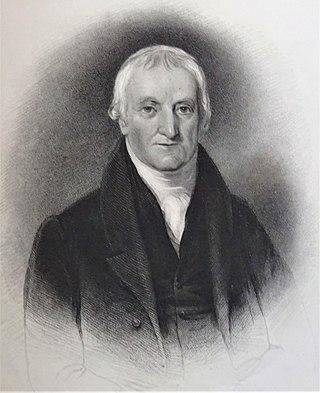
John Syme was a Scottish lawyer and one of the poet Robert Burns's closest friends during his time in Dumfries. In the summers of 1793 and 1794 he joined Burns on his two short tours of Galloway. Syme and Alexander Cunningham were amongst the most active of the friends and admirers of Burns's works who raised funds for the poet's family and for his mausoleum with the assistance of others such as James Currie. Together with Dr Willam Maxwell he arranged Burns's funeral.

Robert Graham of Fintry was the 12th Laird of Fintry near Dundee and was one of Robert Burns's most supportive patrons, correspondent and loyal associate. Appointed a Commissioner of the Scottish Board of Excise he assisted Burns with his Excise career and during his 'loyalty' difficulties. He was a great admirer of his poetry and Burns wrote several epistles to him. Burns referred to him as "Friend of my Life - True Patron of my Rhymes."
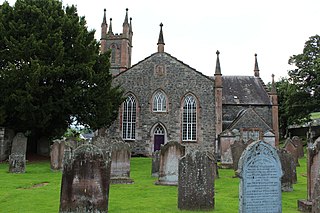
William Nicol (1744–1797) was a Scottish schoolmaster, and, if ill-tempered and vain, one of Robert Burns's close friends. He was born in Annan parish at Dumbretton, Dumfries and Galloway, Scotland. Burns referred to him in one letter as "Kind hearted Willie" and he accompanied the poet on his August 1787 tour of the Highlands. Burns's third son, William Nicol, born at Ellisland Farm in 1791, was named after his friend, the poet commenting that his newborn son had "that propensity to witty wickedness and manfu' mischief, which even at twa days auld I foresaw would form the striking features of his disposition."
Jean Lorimer (1775–1831) was a friend of the poet Robert Burns, often referred to by him as the "Lassie wi' the lint-white locks" or "Chloris". Lorimer was born at Craigieburn House on a small estate near Moffat and from 1788 to 1791 was a neighbour of Burns when he was living at Ellisland Farm, her father's new farm being at Kemmishall or Kemys Hall, Kirkmahoe Parish, two miles to the south of Ellisland on the opposite bank of the Nith. Burns commented "The Lady on whom it was made, is one of the finest women in Scotland" in a letter to George Thomson, enclosing one of the two dozen or so songs that he wrote for her. They first met when she was a teenager through his excise duties bringing him to their farm.
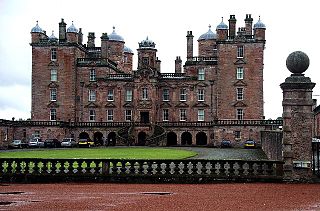
John McMurdo (1743–1803) was a friend of Robert Burns who became the chamberlain to the Duke of Queensberry at Drumlanrig Castle where the poet was a frequent visitor. His eldest daughter Jean (1777-1839) was also a close friend of Burns, who wrote the song "Bonie Jean" in her honour. As an old Nithsdale family the McMurdos were related to the Sharpes of Hoddam, the Charteris of Amisfield, the Fergussons of Craigdarroch, Dr James Currie and the Duncans of Torthorwald amongst others.

Edward Whigham (1750–1823) was the landlord of a coaching inn, a bailie, Provost of Sanquhar, bibliophile and one of Robert Burns's close friends during his Nithsdale and Dumfries days. Edward married Jane Osborne who died on 6 October 1846.
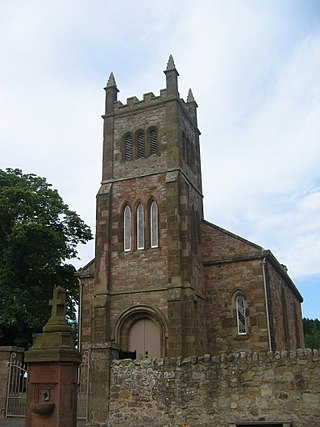
Annabella Burns or Nannie Burns (1764–1832) was the second oldest sister of the poet Robert Burns, and the last child born to William Burness and Agnes Broun whilst at the Alloway cottage. She was born on the 14 November 1764 and she was christened on 17 November by Rev. William Dalrymple, the minister of Ayr Parish Church. When she died in 1832 she was the last member of Gilbert Burns's household at Grant's Brae to be buried at the Bolton Kirk family lair. Gilbert Burns had died, also aged 67, five years earlier in 1832.

John Burns (1769–1785) was the youngest brother of the poet Robert Burns and the last son born to William Burness and Agnes Broun. John was born at Mount Oliphant Farm on the Doonholm Estate near Alloway on the 12 July 1769. He was christened circa 21 July 1769 by Rev. Rev William Dalrymple.

William Nicol Burns (1791–1872) was the sixth child, third born and second surviving son born to the poet Robert Burns when he was 32 and his wife Jean Armour was 26. William was born at Ellisland Farm in Dunscore parish, shortly before the family moved to Dumfries in 1791. His first and middle name was added in honour of William Nicol, Robert's friend.
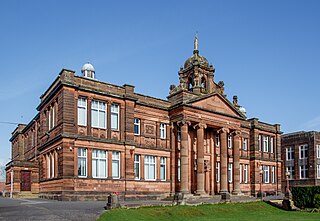
Thomas White (1758–1825) was a close and loyal friend of the Scottish poet Robert Burns, a mathematician of note and eventually Rector (headteacher) of Dumfries Academy.






















